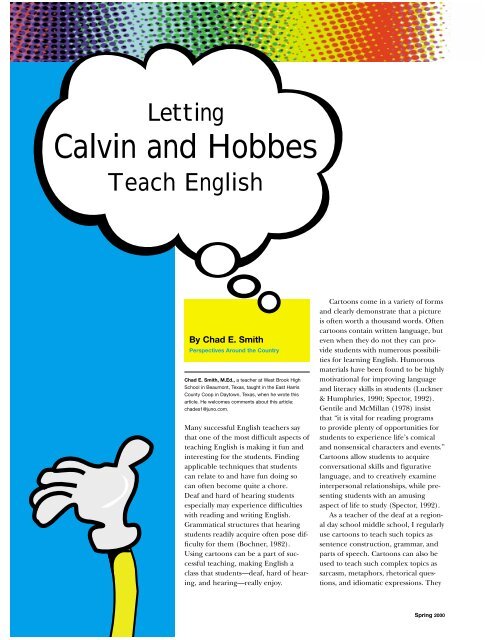Deaf ESL Students - Gallaudet University
Deaf ESL Students - Gallaudet University
Deaf ESL Students - Gallaudet University
Create successful ePaper yourself
Turn your PDF publications into a flip-book with our unique Google optimized e-Paper software.
Letting<br />
Calvin and Hobbes<br />
Teach English<br />
By Chad E. Smith<br />
Perspectives Around the Country<br />
Chad E. Smith, M.Ed., a teacher at West Brook High<br />
School in Beaumont, Texas, taught in the East Harris<br />
County Coop in Daytown, Texas, when he wrote this<br />
article. He welcomes comments about this article:<br />
chades1@juno.com.<br />
Many successful English teachers say<br />
that one of the most difficult aspects of<br />
teaching English is making it fun and<br />
interesting for the students. Finding<br />
applicable techniques that students<br />
can relate to and have fun doing so<br />
can often become quite a chore.<br />
<strong>Deaf</strong> and hard of hearing students<br />
especially may experience difficulties<br />
with reading and writing English.<br />
Grammatical structures that hearing<br />
students readily acquire often pose difficulty<br />
for them (Bochner, 1982).<br />
Using cartoons can be a part of successful<br />
teaching, making English a<br />
class that students—deaf, hard of hearing,<br />
and hearing—really enjoy.<br />
Cartoons come in a variety of forms<br />
and clearly demonstrate that a picture<br />
is often worth a thousand words. Often<br />
cartoons contain written language, but<br />
even when they do not they can provide<br />
students with numerous possibilities<br />
for learning English. Humorous<br />
materials have been found to be highly<br />
motivational for improving language<br />
and literacy skills in students (Luckner<br />
& Humphries, 1990; Spector, 1992).<br />
Gentile and McMillan (1978) insist<br />
that “it is vital for reading programs<br />
to provide plenty of opportunities for<br />
students to experience life’s comical<br />
and nonsensical characters and events.”<br />
Cartoons allow students to acquire<br />
conversational skills and figurative<br />
language, and to creatively examine<br />
interpersonal relationships, while presenting<br />
students with an amusing<br />
aspect of life to study (Spector, 1992).<br />
As a teacher of the deaf at a regional<br />
day school middle school, I regularly<br />
use cartoons to teach such topics as<br />
sentence construction, grammar, and<br />
parts of speech. Cartoons can also be<br />
used to teach such complex topics as<br />
sarcasm, metaphors, rhetorical questions,<br />
and idiomatic expressions. They<br />
Spring 2000
















